
If you run or own a retail business, you know how competitive the sector is. Multiple businesses are selling the same products as you. As a result, you’re all vying for the same customer groups’ attention.
Hence, you must constantly communicate and nurture your customers and target audience to stand out. One of the best ways to do this is through effective email marketing. By sending targeted and interesting emails to your audience, you can keep your business top-of-mind and drive sales.
But where do you start?
Here are tips you should follow for an effective email marketing plan that delivers results for your retail business.
What Is an Email Marketing Plan?
An email marketing plan is a document that outlines how you will use emails to communicate with your customers and prospects. You want to achieve specific marketing and sales goals with these emails. You can look at the plan as a roadmap for your email marketing efforts.
The plan normally includes specific details about your current and potential customer base, email content type, email sending frequency, email design, and format. It also includes the metrics you’ll be using to track and measure the success of your email marketing campaigns.
The details of an email marketing plan may differ for different businesses because each business has unique goals, target audiences, and products or services.
For example, email marketing for SaaS may focus on generating leads and retaining customers. Meanwhile, email marketing for retail businesses may focus on promoting products and boosting sales. The point is, each business’s email marketing plan should be tailored to its specific goals and target audience.
What Are the Benefits of Email Marketing for Retailers
Email marketing is an incredibly powerful tool that retail marketers should include in their digital marketing strategy. In addition to its cost-effectiveness, the strategy also offers a range of benefits, including
1. Increased Sales
Retailers can boost their sales through email marketing by sending targeted emails to their customers.
Since you’ll have segmented your email list based on your customer’s interests and preferences, you can promote the most relevant products and special offers to your customers. This increases the likelihood of your customers purchasing from you.
Email marketing is also an effective tool for targeted product recommendations, upselling, and cross-selling based on customers’ buying and browsing history. Relevant recommendations will encourage the email recipients to buy.
Picture this: a customer recently purchased a new laptop from your electronics store. You could email them accessories recommendations such as laptop bags or a wireless mouse to increase their chances of buying from you again.
Here’s a great example of a product recommendation email:
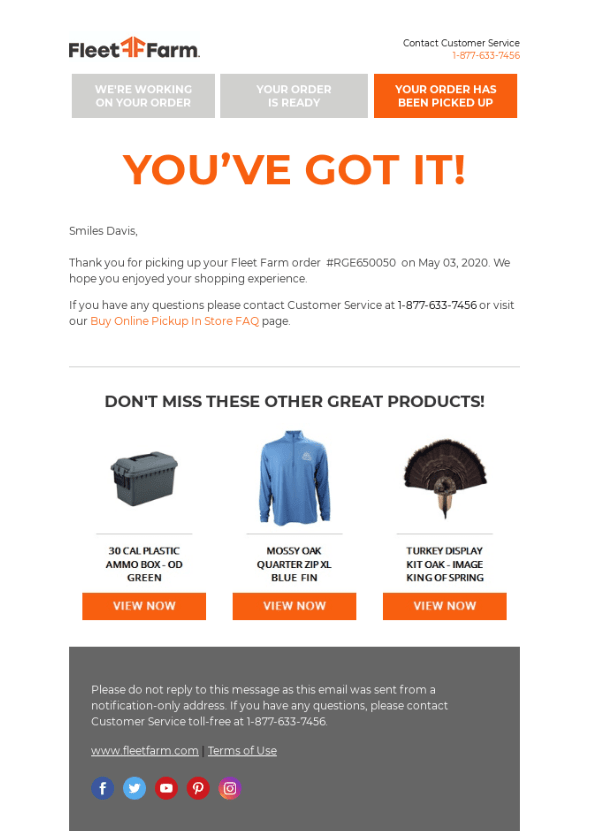
Besides boosting new sales, you can use email marketing to regain lost sales through cart abandonment and re-engagement emails. By reminding customers of their interest in a product through these emails, you encourage customers to complete their purchases.
2. Customer Engagement
Another significant email marketing benefit for retailers is its ability to engage customers and keep your business top-of-mind.
Email marketing helps you share valuable content with your customers, from product updates and industry news to educational resources and customer stories. This keeps your followers engaged and interested in what your business has to offer. It then leads to increased brand loyalty and customer lifetime value.
You can also send fun and interactive content, like surveys and polls, that encourages customers’ direct engagement. For example, if you send a survey asking for customer feedback on a recent purchase, you encourage direct engagement with your business. It also helps to improve customer satisfaction.
Moreover, email marketing offers a unique opportunity to personalize your communication with customers and send emails that speak directly to their interests and needs. This shows your customers that you value them and also encourages them to engage with your business.
3. Relationship-Building
Building strong customer relationships is essential for long-term success in retail. Email marketing can be an incredibly effective strategy for achieving this goal.
The email marketing strategy encourages regular communication with your customers, even when it has been a while since they last purchased. By sending these consistent emails, you keep your brand top-of-mind and maintain a presence in customers’ lives. This helps strengthen the relationship.
You can also automate your email communication easily. As a result, you can send the right message at the right time to the right people. All you need are good automated workflows and responses to triggers in a series of emails to nurture your relationship with your customers.
For instance, you create a workflow for cart abandonment. Once a customer adds an item to their cart and does not proceed to checkout, you can send a cart reminder email after a few hours. Then, wait a day or two to send a follow-up. After this, you can send promotional discount emails to encourage the customer to complete the purchase.
It’s easier to customize pre-designed workflow templates with email service providers like Smaily. For instance, here’s an email automation of the cart email example below:
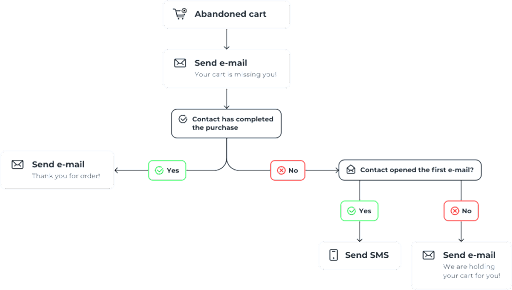
Finally, for your retail business to enjoy each of the benefits above, you must build and maintain an active email list that is interested and willing to engage with your business. So ensure you constantly validate email addresses. There are email verification services you can avail of for this.
Analyzing Retail Industries
Retail is a broad industry with a wide range of businesses, from small independent retailers to multinational chains. Retailers can be brick-and-mortar, online, or a combination. In this section, we’ll take a closer look at the key categories of the retail sector.
-
Apparel retailers
Apparel retailers consist of businesses selling clothing, shoes, and accessories. This industry is highly competitive due to the constantly changing fashion landscape, consumer preferences, and fast-moving trends.
Some apparel retailers offer all items, while others specialize in specific consumer groups. For instance, an apparel retailer may provide children-only clothing and shoes. Another may specialize in women’s apparel.
Some popular apparel retailers include H&M, Zara, Forever 21, Nike, and Adidas.
-
Grocery Retailers
Grocery retailers are essential to the retail industry. They provide food, household essentials, and personal hygiene products.
This industry has seen significant growth in recent years, with many businesses shifting towards online sales and delivery services for customer convenience. Some popular groceries retailers you might know include Walmart, Kroger, Whole Foods, Aldi, and Trader Joe’s (or in Estonia, Selver, Coop, Rimi, Prisma, and Maxima).
-
Electronics Retailers
Electronics retailers sell technology products like smartphones, laptops, and other gadgets.
This industry is highly competitive, with constant new technology product releases and innovations emerging.
Examples of well-known electronics retailers include businesses and online retailers like Best Buy, Microsoft, Amazon, and Apple (or in Estonia, Euronics, Smartech, Photopoint, etc.).
-
Sporting Goods Retailers
Sporting goods traders sell equipment and clothing for various sports and outdoor activities.
This industry is highly seasonal. It’s based on the nature of the sport or outdoor activity. For instance, for businesses that sell skiing equipment and clothing, sales will often peak during winter since most skiing activities tend to be held then.
Popular sporting goods retailers include Decathlon, REI, Sports Authority, and Bass Pro Shops (or in Estonia, Sportland, Sports Direct, AT sport, etc.).
-
Beauty Retailers
Beauty retailers sell cosmetics, skincare, and personal care products. While beauty products are always in style and demand, the beauty retail industry is highly competitive, with new trends and product releases constantly appearing.
However, email marketing can help your beauty retail business stand out by helping you stay in touch with customers and promote new products and services. Popular beauty retailers include Sephora, Maybelline, MAC Cosmetics, L’Oreal, and Estee Lauder.
6 Tips for an Effective Email Marketing Plan in the Retail Industry
As mentioned earlier, you must ensure an effective email marketing plan for retailers. Just follow these six tips to achieve that:
1. Come up with a Suitable Email Campaign
Creating a good email campaign is essential to the success of any email marketing plan for retailers. A suitable email campaign is designed to resonate with your target audience. It should also align with your business’s email campaign budget and goals.
So how do you create this email campaign? Here are a few tips you should consider following:
- Define your goals: To find your goals, you must first determine your email campaign’s purpose. Are you looking to drive sales, promote a new product, increase website traffic, or build brand awareness? Clear goals make it easy to tailor the content and design of the email campaign accordingly.
- Know your target audience: Understanding your target audience is critical to creating a successful email campaign. To achieve this, segment your email list to create targeted messages that resonate with your customers–we’ll discuss this further in the next point.
- Create engaging content: The content of your email should be informative, engaging, and visually appealing. So, craft personalized messages. Include relevant visuals that complement the email copy while grabbing your subscribers’ attention.
- Choose the right format: Decide on the best format for your content and audience. For example, an email newsletter format may work well for a sporting goods retailer. A promotional email may work better for a beauty retailer.
Choose your email campaign wisely. After all, your plan may also impact your other forms of marketing.
For instance, if you decide to combine email marketing with social media by including social media buttons in your emails, you won’t just get to grow your email list and nurture relationships with your subscribers.
You’ll also boost your social media following and engagement. Just think about it. Once your subscribers share your email content on social media, people on your chosen social platform/s will find that content. If they like the content, you can gain more Instagram followers, increase Facebook likes, and boost your retweets, whichever applies.
In other words, in a scenario where you implement a campaign combining email marketing with social media, if your email campaign fails, your social media marketing campaign will fail as well.
2. Segment Your Email List
Segmenting your email subscriber list allows you to tailor your email marketing campaigns to specific groups of customers. This, in turn, boosts engagement and performance rates.
Retail businesses can segment their email lists to create more effective campaigns in the following ways:
- Demographic segmentation: You can divide your email list based on demographic characteristics such as age, gender, location, and income level.
- Purchase history segmentation: This type of segmentation is based on customers’ previous purchases. It allows you to send relevant messages and offers on specific product selections customers previously showed interest in.
- Behavioral segmentation: You can also segment your email list based on customers’ purchase behavior, such as website visits, abandoned carts, and email engagement.
- Interest segmentation: This type allows you to send relevant emails that align with the customer’s interests and preferences. You can base it on personal data entered while collecting their email address via email signup forms or customer surveys.
Proper email list segmentation makes sending personalized content to the right audience easier. This is key in a retail email marketing strategy. Research also shows that 80% of customers are likelier to buy from brands that provide tailored customer experiences.
3. Use Attention-grabbing Subject Lines
The subject line is the first thing customers see when they receive an email from your business. Therefore, it is important to ensure they’re captivating enough to encourage customers to open your emails.
To ensure your subject lines are attention-grabbing, start by keeping your subject lines short, preferably around 30-50 characters. Such subject lines are easy to read through, which boosts your email open rate.
Also, communicate the value proposition in your email subject line. Doing this will grab your recipients’ attention and encourage them to open your email. Your value proposition can be anything from discounts to an exclusive event invite. A great example could be “Get $20 off and free shipping on your first purchase”.
You can also use humor or puns to craft email subject lines that stand out and use emojis sparingly to add emotions and personality. Check out the example below:
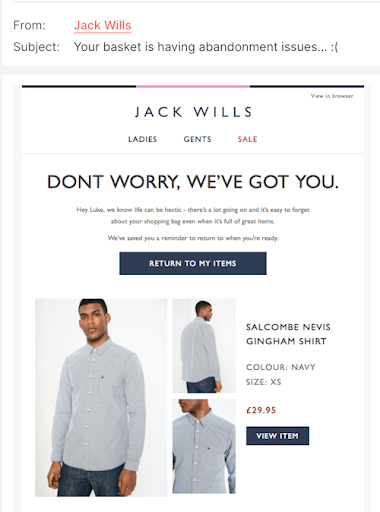
Next, ensure you personalize your subject lines. You can include the recipient’s first name and connect it to their recent activity or purchase history. For instance, you can use the subject line “Hi Ann, you left something in your cart.”
In addition, create a sense of urgency and exclusivity with your subject lines. Use words and phrases to encourage customers to open emails immediately. A great example is “Last chance to save 30% on all the products” or the one shown below.
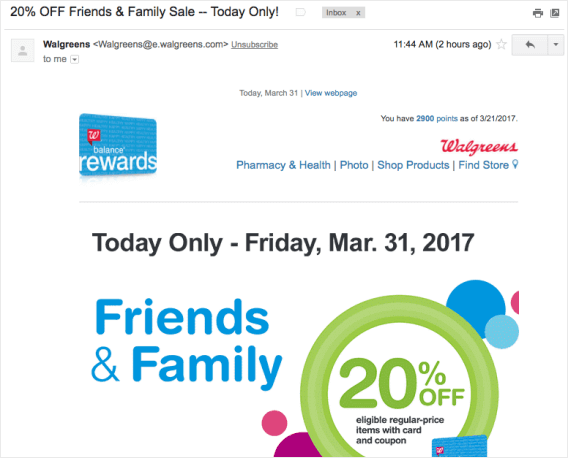
Finally, use creativity and avoid using spammy and misleading email subject lines. These will lead customers to lose trust in your business and unsubscribe. To avoid this, ensure your subject lines align with your email content.
If you don’t have a copywriter on your team to write good subject lines, you can use an AI content generator. Ask Writer can give you a list of good email subject lines you can use:
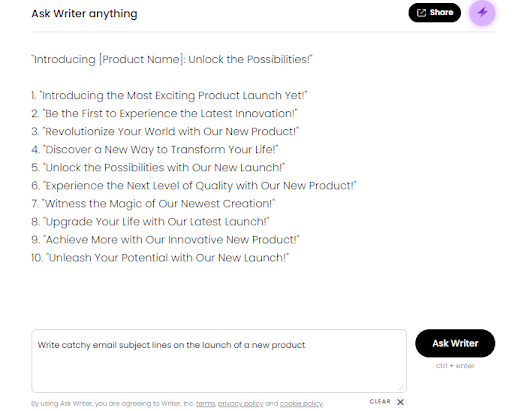
All you need to do is insert a prompt for it to produce a list.
4. Optimize Your Email For Mobile Devices
More and more customers are opening emails on mobile devices. That’s why it’s key to optimize your email for mobile devices.
Here are some tips on how retail businesses can optimize their emails for mobile devices:
- Use a responsive design: Responsive design enables emails to adjust their layout and font size to fit the screen of any device. This makes the emails easier to read and interact with.
- Keep it simple: Emails should have a clean and simple design to boost readability and navigability. Avoid using too many text blocks or images that could clutter the email.
- Use a single-column layout: A single-column layout ensures that the email content is easy to read and scroll through on small screens. It also simplifies the design and reduces the risk of broken formatting.
- Optimize images: Use optimized small images that will load quickly on mobile devices. Large images take too long to load, leading to slower email load times and higher bounce rates.
- Use CTA button: A clickable CTA button is easier to click on a smartphone compared to plain text CTAs links.
By optimizing emails for mobile devices, retailers can ensure their emails are accessible and engaging for their mobile audience. This can lead to higher open and click-through rates, grown engagement, and, ultimately, higher sales.
5. Include a Clear Call-to-action (CTA)
For an effective email marketing plan for retailers, make sure you have a clear CTA. A clear CTA encourages people to take a specific action. That could be making a purchase, signing up for a newsletter, or downloading an ebook.
To ensure your CTA is clear, use contrasting colors to stand out against everything else on the page. Check out Sjaak’s example below:
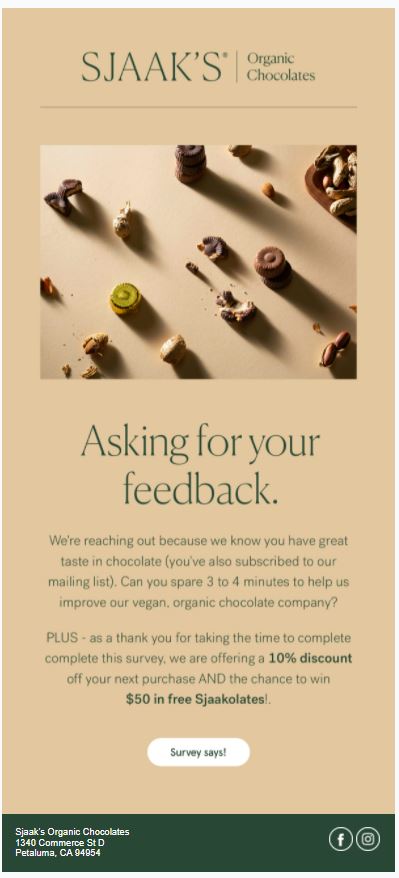
If your CTA’s color matches the rest of your text, it will blend into the background. That will make it easy to miss.
Also, leave plenty of white spaces around your CTA button to help it stand out more.
In addition, ensure your CTA is placed in a way that it’s clearly visible. That may vary depending on your email content and goal.
For instance, you can place it above the fold to capture the attention of readers who may not scroll to the bottom. This is what Best Buy did in the example below:
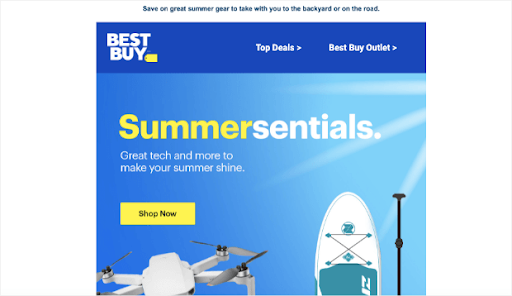
Alternatively, you can choose to build rapport with your recipients first before asking them to take action. So, you’d place your CTA at the end of your email, like in this Outdoor Voices example.
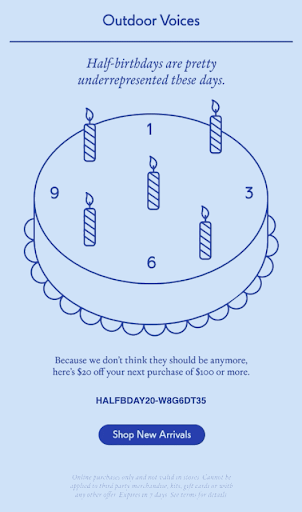
Test different placements and see which works best for your target audience and campaign.
Finally, your CTA should also use action-oriented or active language. The language should communicate the intended action. For example, you could use the CTA “Shop Now” or “Get 20% Off”.
6. Test and Measure Your Email Campaigns
Testing and measuring email campaigns is key to an effective email marketing plan for retailers. It allows retail businesses to evaluate their email campaigns’ effectiveness and identify improvement areas. By doing so, they can optimize their campaigns and improve their overall return on investment (ROI).
The first step is defining the specific metrics you want to track. Some standard email marketing metrics you can consider for your retail business campaigns include:
- Open rates: The percentage of people who opened an email message or newsletter.
- Click-through rates: The number of people who clicked on a link within your email
- Unsubscribe rates: The percentage of people who unsubscribed from a mailing list or newsletter.
- Conversion rates: The total percentage of website visitors who take a desired action, such as making a purchase or filling out a signup form.
- Customer lifetime value: The total value of a customer’s business over the entire period of their relationship with a company.
Besides the metrics, you can also run A/B tests on different versions of your email campaign. This will help you determine the email elements that drive better engagement and conversions. Some of the variables you can test include subject lines, calls-to-action, and email content.
The next step, after testing, is collecting email campaign data and analyzing it to identify the trends and areas that require improvement. Look for patterns in your analytics. Then use the information gained from your analysis to make data-backed decisions. As a result, your email campaigns will improve over time.
Remember, testing and measuring your email campaigns is an ongoing process if you want to boost your overall ROI.
In Closing
Email marketing is a powerful strategy. It can help boost revenue for retail businesses of all sizes through increased sales, customer engagement, and strong customer relationships.
Follow the six tips outlined in this article for an effective email marketing plan for retailers. Create suitable email campaigns, segment your email list, and use attention-grabbing subject lines. Also, optimize your email for mobile phones and include clear CTAs. Finally, test and measure your email campaigns.
Follow these tips, and you’ll run effective campaigns that boost engagement and sales for your retail business. All the best!
 About the Author
About the Author
Owen Baker is a content marketer for Voila Norbert, an online email verification tool. He has spent most of the last decade working online for a range of marketing companies. When he’s not busy writing, you can find him in the kitchen mastering new dishes.